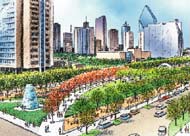Link to article here.
Texas Gov. Rick Perry to run for re-election in 2010
Thursday, April 17, 2008
By GROMER JEFFERS JR. and CHRISTY HOPPE / The Dallas Morning News
Gov. Rick Perry told The Dallas Morning News on Thursday that he would seek re-election as governor in 2010.
During a break in a Republican Governors Association forum being held in Grapevine, Mr. Perry said that he would like to return for a third full term as governor.
When asked whether the gubernatorial field would include Sen. Kay Bailey Hutchison, Lt. Gov. David Dewhurst and himself, Mr. Perry responded , “I don’t know about them, but it will be Perry in 2010.”
“I don’t know about the other two. You need to ask them.”
Mrs. Hutchison appeared unaffected by the governor’s statement. She has earlier said that her decision to run for governor would not be swayed this time by other candidates in the race.
“I am encouraged by the growing number of Texans asking me to return home to run for governor to provide leadership for our state,” she said in a statement Thursday.
“It is too early to make an announcement about the 2010 race. Right now I remain committed to serving the people of Texas in the United States Senate and helping our Republican candidates win crucial elections this fall.”
Mr. Dewhurst also said he would weigh his options later.
“My focus is on the 2009 legislative session and continuing to build on our successes over the past five years. Whatever I decide to do after that will be based on what’s best for Texas,” he said.
Since winning re-election with just 39 percent of the vote in a four-way field in 2006, Mr. Perry has held out the possibility of seeking an unprecedented third four-year term. But his statement Thursday is his most definitive yet that he would do so, though much could change in the two-and-a-half years until the next gubernatorial election.
Mr. Perry will soon become the longest-serving governor in Texas history. He took over for George W. Bush when Mr. Bush resigned in late 2000 to become president. The state has no term limits for governor.
Last year, Mr. Perry had expressed doubt as to whether he wanted another term, saying he would look at doing other things.
It has been speculated that Mr. Perry was positioning himself to be a vice presidential candidate, but he said Thursday that he would not accept such an offer from Arizona Sen. John McCain, the party’s all-but-certain nominee.
Longtime Republican consultant Bill Miller said the governor’s remark not only tips his hand, but tips the political balance.
“Most politicians who have been around awhile understand that when you become a lame duck, you really lose leverage and you lose your ability to get some things done, particularly hard things,” Mr. Miller said.
Eight months before a legislative session, it might be wise to strengthen your clout with lawmakers by letting them know you intend to be in the executive office for awhile, Mr. Miller said. “It’s the nature of politics.”
As for Mr. Perry’s election chances, Mr. Miller said he expects the governor will meet formidable competition in the 2010 GOP primary. And being the longest serving governor means you are not just battle-tested, but battle-scarred as well, he said.
“He’s got the most recent election and his polling numbers indicate it will not be an easy task for him to be reelected,” Mr. Miller said.
But it would be foolish to underestimate Rick Perry, he said. “The fact is that he’s never lost a political race and he’s had many, many of them.”
Democratic Party chief Boyd Richie suggested Mr. Perry has a lot to run on, including several school funding crises, the Texas Youth Commission sexual abuse scandal, soaring college tuitions, sprouting toll ways and more than 1 million children lacking health insurance.
“That’s the record of Rick Perry and the Republican politicians who masquerade as our leaders while serving the interests of special interest contributors and cronies. Texas Democrats look forward to 2010,” Mr. Richie said.
Mr. Perry also said Thursday that he thought Tom Craddick would win re-election as House speaker. Mr. Craddick, embattled over his leadership style and his declaration that he had absolute authority in running the House last year, is expected to face several challengers for the job, even if Republicans maintain their thin majority in the House.


 I enjoy baking, and “scratch” cornbread is my favorite kitchen oeuvre. I use stone-ground corn meal, and the product is gluten-free — nix on the cup of wheat flour you’ll find in many recipes.
I enjoy baking, and “scratch” cornbread is my favorite kitchen oeuvre. I use stone-ground corn meal, and the product is gluten-free — nix on the cup of wheat flour you’ll find in many recipes. The Woodall Rodgers Park Foundation announced yesterday that the Texas Department of Transportation (TxDOT) would hand over $20 million in gas tax funds to help build a 5.2 acre park near downtown Dallas. The $67 million park is intended to serve as a model public-private partnership with a restaurant, a children’s playground and a dog park. It will have no roads.
The Woodall Rodgers Park Foundation announced yesterday that the Texas Department of Transportation (TxDOT) would hand over $20 million in gas tax funds to help build a 5.2 acre park near downtown Dallas. The $67 million park is intended to serve as a model public-private partnership with a restaurant, a children’s playground and a dog park. It will have no roads.